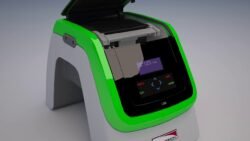
UV254 Analyzer
Title: Understanding UV254 Analyzers: An In-Depth Exploration of Their Role in Water Quality Assessment
Introduction
The ever-growing demand for clean and safe water has propelled advancements in water quality assessment technologies. Among these, the UV254 analyzer has emerged as a critical tool for measuring organic contaminants in water resources. This detailed article aims to provide an exhaustive exploration of UV254 analyzers, their working principles, applications, benefits, and limitations in water quality monitoring.
1. The Basics of UV254 Measurement
UV254 refers to ultraviolet light at a wavelength of 254 nanometers. This specific wavelength is absorbed by organic molecules, particularly those with aromatic rings, such as humic and fulvic acids, which are prevalent in natural water bodies. The UV254 analyzer measures the absorbance of UV light at this concentration-dependent wavelength to estimate the concentration of organic compounds in the water, which is crucial for understanding water quality.
2. Key Components and Working Principle of UV254 Analyzers
A UV254 analyzer consists of several key components, including:
-
- UV Light Source: Typically a mercury or xenon lamp that emits a stable beam of ultraviolet light at 254 nm.
-
- Sample Flow Cell: Where the water sample passes through, allowing for direct interaction with the UV light.
-
- Photodetector: Detects the intensity of the transmitted UV light after it passes through the sample.
-
- Data Processor: Calculates the absorbance and translates it into meaningful data.
The working principle is straightforward: UV light is passed through a flow cell containing the water sample. Organic compounds absorb part of this light, reducing the intensity that reaches the photodetector. The device calculates the absorbance using Beer-Lambert’s law, which correlates absorbance to the concentration of absorbent species in the sample.
3. Applications of UV254 Analyzers
UV254 analyzers are utilized extensively across several domains:
-
- Drinking Water Treatment: Helps in assessing the effectiveness of water treatment processes, like coagulation and filtration, to ensure the removal of organic contaminants.
-
- Wastewater Treatment: Monitors the organic load before and after treatment, ensuring compliance with regulatory standards.
-
- Environmental Monitoring: Assists in detecting changes in natural water bodies due to pollution or natural factors.
-
- Industrial Processes: Used in industries needing precise water quality management, such as food and beverage, pharmaceuticals, and chemical manufacturing.
4. Advantages of Using UV254 Analyzers
-
- Rapid and Real-Time Monitoring: Unlike traditional methods like TOC (Total Organic Carbon) analysis, UV254 provides almost instantaneous results.
-
- Non-Destructive Analysis: The method does not alter the sample, allowing for further testing if needed.
-
- Cost-Effective: Minimizes operational costs due to lower energy requirements and fewer consumables.
-
- Enhanced Sensitivity: Capable of detecting low levels of UV-absorbing organic compounds, crucial for early contamination detection.
-
- Automation and Integration: Modern UV254 analyzers can be integrated into automated water quality monitoring systems, offering continuous data outputs.
5. Limitations and Challenges
Despite their advantages, UV254 analyzers come with certain limitations:
-
- Selective Sensitivity: They predominantly measure aromatic compounds and may not detect non-absorbing organics.
-
- Interference from Inorganic Substances: Particulate matter or turbidity in water can scatter light and cause erroneous readings.
-
- Calibration and Maintenance Requirements: Regular calibration and cleaning are necessary to ensure accuracy and reliability.
6. Calibration and Maintenance
To mitigate errors and improve accuracy, routine calibration against standardized solutions is essential. Moreover, the sample flow path and optical components should be regularly cleaned to avoid fouling, especially when analyzing complex wastewater samples.
7. Integration with Water Quality Management Systems
UV254 analyzers can be integrated into broader water quality management systems, often interfaced with software that processes data for comprehensive analysis. This integration supports regulatory compliance, actions to improve treatment processes, and communication of results to stakeholders.
8. Case Studies and Practical Implementations
-
- Municipal Water Treatment Plants: Implementation of UV254 analyzers in municipal plants has demonstrated significant improvements in organic contaminant monitoring, facilitating better water quality for urban populations.
-
- Industrial Wastewater Monitoring: Industries have utilized UV254 analyzers to monitor wastewater streams, allowing for timely interventions to prevent environmental damage.
9. The Future of UV254 Analyzers
The evolution of UV254 analyzers continues with advancements in sensor technology, data analytics, and smart connectivity features, promising enhanced functionalities and broader capabilities. Future developments may focus on integrating AI and machine learning to predict water quality trends and automate decision-making processes.
Conclusion
The UV254 analyzer is a pivotal tool in the arsenal of water quality monitoring technologies. Its ability to provide rapid, accurate, and cost-effective assessments of organic pollutants makes it indispensable for ensuring safe drinking water, efficient wastewater treatment, and preserving aquatic environments. As technology progresses, the utility and precision of these analyzers are expected to further expand, solidifying their role in safeguarding public health and environmental quality.
This article comprehensively covers the UV254 analyzer’s mechanisms, uses, benefits, and future directions, providing readers with a detailed understanding of its critical role in water quality assessment.
